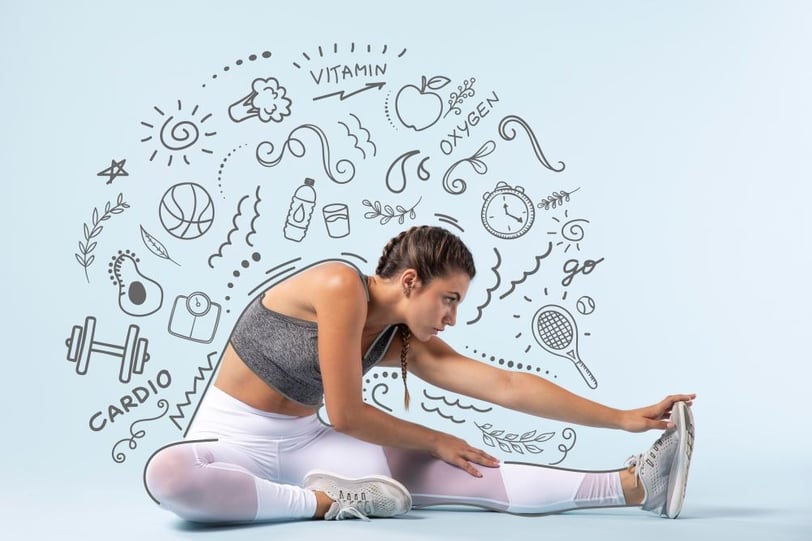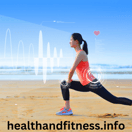How to balance health and fitness
Discover effective strategies to balance health and fitness, combining exercise, nutrition, and self-care for a sustainable, healthy lifestyle.
Health Fitness Team
2/2/20253 min read


Physical activity or exercise is the only way to improve your health and reduce the risk of developing several diseases like better mood, better brain function, stronger bones and muscles, diabetes, cancer and cardiovascular disease.
Physical activity and exercise can have immediate and long-term health benefits like increasing blood flow and oxygen delivery in your body. Most importantly, regular activity can improve your quality of life.
A minimum of 30 minutes a day can allow you to enjoy these benefits.
1- HEALTH:
From time immemorial man has been interested in trying to control disease. The medicine man, the priest, the herbalist and the magician, all undertook in various ways to cure man`s disease and/or to bring relief to the sick.
2-WHO DEFINITION:
The widely accepted definition of health is that given by the World Health Organization (1948) in the preamble to its constitution, which is as follows:
‘’ (Health is a state of complete physical, mental and social well-being and not merely an absence of disease or infirmity)’’
3-DETERMINANTS OF HEALTH:
HEALTH
Health are four types:
a-) Communities:
Human rights
Biological behavior
b-) Family:
Gender
Information and communication
Equity and social justice
c-) Society`s:
Environment
Socio economic
d-) Individuals:
Science and technology
Information and communication
Socio culture
4-Indicators of health:
Indicators are required not only to measure the health status of a community, but also to compare the health status of one country with that of another; for assessment of health care needs; for allocation of scarce resources; and for monitoring and evaluation of health services, activities, and programs. Indicators help to measure the extent to which the objectives and targets of a program are being attained.
5-There are several types of indicators are classified as:
Motility indicators
Morbidity indicators
Disability rates
Nutritional status indicators
Utilization indicators
Indicators of social and mental health
Environmental indicators
Socio economic indicators
Other indicators
FITNESS
1-There are numerous fitness benefits that can enhance your health and overall well-being. Here are some keys advantages:
Workout plans
Weight loss and muscles building
Nutrition and dieting
Yoga and gym workout
Tips for staying motivated
Fitness equipment
Mental health
Energy levels
Immunity
Sleep quality
2-NON-COMMUNICABLE DISEASES
(NCD`s)
The four main types:
Cardiovascular diseases (CVDs)
Cancer
Chronic respiratory diseases
Diabetes
Other types
Hypertension
Dyslipidemia
Obesity
Metabolic Syndrome
Rheumatoid arthritis (RA)
Cerebrovascular disease
Osteopenia/osteoporosis
Degenerative disc disease
Sarcopenia and frailty
Depression
Cognitive impairment
Neurodegenerative disease
3-RISK FACTOR:
If we avoid fitness, there are many risk factors that can arise. Here are some key risk factors to consider.
1-Obesity: Not engaging in regular exercise can lead to weight gain, which can result in obesity.
2-Diabetes: Regular physical activity boosts insulin sensitivity, which helps control blood sugar levels.
3-Mental health issues: Fitness and exercise are beneficial for mental health. Inactivity can lead to increased anxiety, depression, and stress.
4-Reduced life expectancy: Physical inactivity can deteriorate overall health, which may lead to a shorter life expectancy.
5-Weak muscles and bones: Regular exercise strengthen muscles and bones. If we avoid it can increase the risk of osteoporosis and muscles weakness.
MODIFIABLE:
Tobacco
HTN
Physical inactivity
Alcohol
Elevated blood sugar
Elevated cholesterol levels
Improper diet
NON-MODIFIABLE:
Age
Gender
Family history
Ethnicity
Past medical history
6-Indicators of Obesity:
BMI or Quadlet index
Formula=Weight in kg/Height in m^2
Classification of BMI-
1.According to WHO:
Normal BMI - 18.5-24.99
1-Overweight (Pre obese) - 25-29.9
2-Obese class 1 - 30-34.9
3-Obese class 2 - 35-39.9
4-Obese class 3 - >40
7-Other Indicators of Obesity
1-SKIN FOLD THICKNESS
Measured by Harpenden Caliper
Measured at 4 sites-
Subscapular
Supra-iliac
Mid-biceps
Mid-triceps
Sum of all 4 sites measurement.
Males->40.
Females->50.
2-Waist circumference.
Males->102.
Females->80.
Indian population waist circumference.
Males->90.
Females->80.
3-Waist-hip ratio
Males->1.
Females->0.85.
8-Coronary Artery Disease
It contributes the maximum DALY.
Preventive strategy:
Primordial
Best level of prevention.
Do not adopt smoking.
Primary prevention
Lead a healthy lifestyle.
Population strategies or high-risk strategies are also used.
Secondary prevention
Early diagnosis and treatment.
For CAD-Angioplasty can be done.
Tertiary prevention
Stop smoking after an attack
9-Diabetes Mellitus
Almost 7-8% of the population in India is diabetic.
The urine of the diabetic patient contains glucose- Glucosuria.
Sensitivity of glycosuria is less.
Urine sugar is not recommended for epidemiological purposes.
Crude idea-Random blood sugar
It is the first but not more reliable
Glucose tolerance test is done – 2 hours postprandial values are taken.
10-Diagnostic Criteria According to WHO
Diabetes - Diabetes Mellitus
Fasting plasma glucose - 7.0 mmol/L (126 mg/dl)
2-hour plasma glucose - 11.1 mmol/L (200 mg/dL)
Impaired Glucose Tolerance:
Fasting plasma glucose - <7.0 mmol/L (126 mg/dL)
2-hour plasma glucose - 7.8-11.1 mmol/L (140-200 mg/dL)
11-Rheumatic Heart Disease
Infectious disease.
Most common causative agent: Group A streptococci.
Also- Coxsackie virus can be responsible.
Most common age group: 5-15 years.
Most common valve involvement: Mitral Valve (Mitral valve) stenosis or regurgitation
Risk factors:
Poverty
Lower economic status
Overcrowding
Drug of choice for prevention and prophylaxis- Benzathine Benzylpenicillin
12-Cancer Screening:
It is a process of to detect cancer or precancerous condition in individuals who do not have any symptoms. The primary goal of cancer screening is early detection, which can lead to more effective treatment of cancer is found.
Primary prevention by health education.
Secondary prevention for CA cervix (Acetic acid – Visual inspection), breast (Mammography), tobacco-related cancer by early diagnosis and treatment.
Tertiary prevention by strengthening existing institutions of comprehensive therapy including palliative care.
CA Breast
Most sensitive screening modality for Ca breast Mammography.
Mammography in a woman who’s less than 40 years is difficult because of dense fibrous tissue.
<40 years – self-examination is done.
CA Cervix
PHC level: Visual inspection after application of freshly prepared 5% acetic acid.
CHC level: PAP smear.
